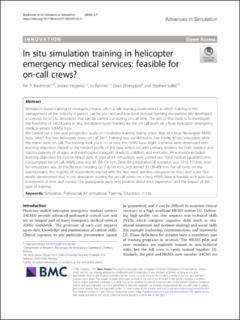| dc.contributor.author | Bredmose, Per Poelhøi | |
| dc.contributor.author | Hagemo, Jostein Skjalg | |
| dc.contributor.author | Røislien, Jo | |
| dc.contributor.author | Østergaard, Doris | |
| dc.contributor.author | Sollid, Stephen J. M. | |
| dc.date.accessioned | 2023-02-09T11:53:26Z | |
| dc.date.available | 2023-02-09T11:53:26Z | |
| dc.date.created | 2020-09-28T19:56:12Z | |
| dc.date.issued | 2020 | |
| dc.identifier.citation | Bredmose, P. P., Hagemo, J., Røislien, J., Østergaard, D., & Sollid, S. (2020). In situ simulation training in helicopter emergency medical services: feasible for on-call crews?. Advances in Simulation, 5(1), 1-7. | en_US |
| dc.identifier.issn | 2059-0628 | |
| dc.identifier.uri | https://hdl.handle.net/11250/3049661 | |
| dc.description.abstract | Simulation-based training of emergency teams offers a safe learning environment in which training in the management of the critically ill patient can be planned and practiced without harming the patient. We developed a concept for in situ simulation that can be carried out during on-call time. The aim of this study is to investigate the feasibility of introducing in situ, simulation-based training for the on-call team on a busy helicopter emergency medical service (HEMS) base.
We carried out a one-year prospective study on simulation training during active duty at a busy Norwegian HEMS base, which has two helicopter crews on call 24/7. Training was conducted as low fidelity in situ simulation while the teams were on call. The training took place on or near the HEMS base. Eight scenarios were developed with learning objectives related to the mission profile of the base which includes primary missions for both medical and trauma patients of all ages, and interhospital transport of adults, children, and neonates. All scenarios included learning objectives for non-technical skills. A total of 44 simulations were carried out. Total median (quartiles) time consumption for on-call HEMS crew was 65 (59-73) min. Time for preparation of scenarios was 10 (5-11) min, time for simulations was 20 (19-26) min, cleaning up 7 (6-10) min, and debrief 35 (30-40) min. For all items on the questionnaire, the majority of respondents replied with the two most positive categories on the Likert scale. Our results demonstrate that in situ simulation training for on-call crews on a busy HEMS base is feasible with judicious investment of time and money. The participants were very positive about their experience and the impact of this type of training. | en_US |
| dc.language.iso | eng | en_US |
| dc.publisher | BMC | en_US |
| dc.rights | Navngivelse 4.0 Internasjonal | * |
| dc.rights.uri | http://creativecommons.org/licenses/by/4.0/deed.no | * |
| dc.title | In situ simulation training in helicopter emergency medical services: feasible for on-call crews? | en_US |
| dc.type | Peer reviewed | en_US |
| dc.type | Journal article | en_US |
| dc.description.version | publishedVersion | en_US |
| dc.rights.holder | The authors | en_US |
| dc.subject.nsi | VDP::Medisinske Fag: 700 | en_US |
| dc.source.journal | Advances in Simulation | en_US |
| dc.identifier.doi | 10.1186/s41077-020-00126-0 | |
| dc.identifier.cristin | 1834540 | |
| dc.relation.project | SHARE - Centre for Resilience in Healthcare: 5091 | en_US |
| dc.relation.project | Norges forskningsråd: 275367 | en_US |
| cristin.ispublished | true | |
| cristin.fulltext | original | |
| cristin.qualitycode | 1 | |

